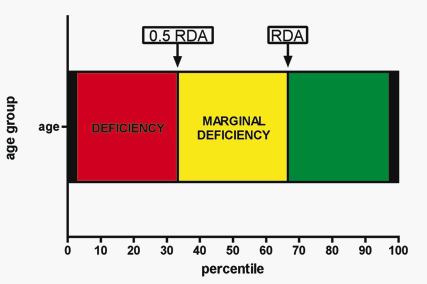David W. Killilea
Research Interests - Continued[SITE UNDER CONSTRUCTION - COMMENTS WELCOME]
Multiparametric Analysis of Micronutrient Deficiencies in the US Population
Micronutrient deficiencies are more common in the US Population than is often appreciated; deficiencies are often pronounced in the elderly and in minority populations (1-4). Moreover, significant metabolic damage may occur with chronic intake of micronutrients that is higher than the level that causes severe deficiency diseases but lower than recommended daily allowance (RDA) (5).
To illustrate the prevalence of moderate deficiencies, we have designed a series of graphs depicting this using micronutrient intake data from the Continuing Survey of Food (CSFII) study conducted by the US Department of Agriculture from 1994-1996. Intakes were estimated from 2 nonconsecutive 24 hour recalls of food intake during in-person interviews. Supplement usage was not included. CSFII information on ethnic background was limited, hence only 2 groups are represented here. For additional information on this data, please see http://www.barc.usda.gov.
Graphs were designed for the following micronutrients. The X-axis indicates the percent of the US population and the Y-axis orders respondents into age groups. Gender and ethnic background are shown on separate graphs. These graphs divide each group into individuals whose intake is at or above the RDA (green), between half the RDA and the full RDA (yellow), and below half the RDA (red). These categories are rather arbitrarily described as marginal deficiency (yellow) and deficiency (red). The goal is to indicate trends of micronutrient adequacy as a function of age, gender, and ethnic background.
Minerals: IRON, MAGNESIUM, ZINC
Vitamins: VITAMIN B6, VITAMIN B12

PLEASE CHECK BACK SOON FOR ADDITIONAL MICRONUTRIENTS AND EXPANSION OF PARAMETERS, INCLUDING ADDITIONAL ETHNIC GROUPS.
NOTE: RDAs are established to indicate optimal intake for >95% of the population; just because an individual might have an intake lower than the RDA does not necessarily mean that the micronutrient level is not adequate. These graphs are for illustration purposes only and are not intended as medical advice.
1. Wakimoto, P and Block, G, 2001. Dietary intake, dietary patterns, and changes with age: an epidemiological perspective. J Gerontol A Biol Sci Med Sci 56: 65-80.
2. Ames, BN, 2003. Delaying the mitochondrial decay of aging - a metabolic tune-up. Alzheimer Dis Assoc Disord 17: S54-S57.
3. Ames, BN, 2003. The metabolic tune-up: metabolic harmony and disease prevention. J Nutr 133: 1544S-1548S.
4. Ames BN, Atamna H, and Killilea DW, 2005. Mineral and vitamin deficiencies can accelerate the mitochondrial decay of aging. Mol Aspects Med.
26:363-78.
5. Ames, BN, 2004. A role for supplements in optimizing health: the metabolic tune-up. Arch. Biochem Biophys 423: 227-234.